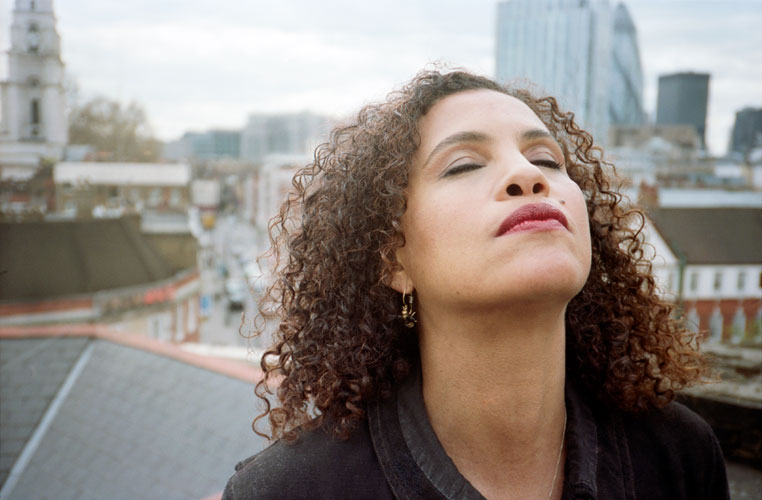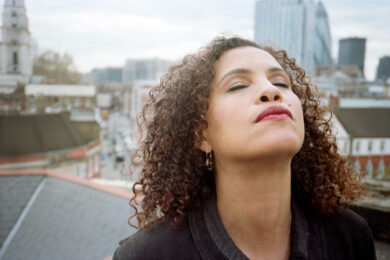All photography by the marvellous Cat Stevens.
Hair and make-up by Ian Jeffries, My-Management
Neneh Cherry is proper cool. She comes into the interview room hooting with laughter, eyes sparkling, practically skipping despite apparently not having slept the night before. You notice that she is wearing a home made necklace fashioned from a vicious looking, spring loaded Lucifer brand mousetrap, a champagne cork and a tiny padlock with a key in it. "That is proper cool", you say to yourself, when you realise you could literally reach out and touch her and then, quite rightly, have your fingers broken for the privilege.
She doesn’t look more than a few years older than she did when she was fronting the post punk, post Pop Group Bristol band Rip Rig + Panic; not that much older than she did when she duetted with Matt Johnson on The The’s unique hit single ‘Slow Train To Dawn’ and like no time at all has elapsed since the album Raw Like Sushi with its astounding, evergreen hybrid pop/dance/hip hop/R&B/soul of ‘Manchild’, ‘Buffalo Stance’ and ‘Kisses On The Wind’.
But it has been a few years. In fact it’s been 18 years since the massive Youssou N’Dour duet ‘7 Seconds’ and 16 since her most recent solo album Man. This is not to say that she hasn’t been busy, but it certainly seems as if she has backed away from the demanding lure of solo fame. Instead she has been recording with her producer husband Cameron McVey and daughter Tyson under the name cirKus, as well as lending her voice to various songs by Pulp, Gorillaz, Timo Maas, Groove Armada and Kleerup.
The collaboration that calls her away from her family home in Sweden today, however, is one of an ostensibly stranger pairing. She has a new album coming out on Smalltown Supersound called Cherry Thing with free jazz trio The Thing. Now, in some ways this is an extremely natural thing when you consider Don Cherry, Neneh’s father.
Don was a famed free jazz trumpeter who played with everyone from Sun Ra to Lou Reed, but most notably he had a long lasting professional and creative relationship with Ornette Coleman. The Thing are not only named after a Don Cherry track but originally convened to play versions of his music. But still it sounds like an unlikely partnership – probably because of Mats Gustafsson’s muscular, hectic and aggressive saxophone style and Neneh’s more sweetly classic pop and soul delivery. The album is a revelation however. They have tackled six cover versions (there are two excellent original pieces here as well) from a wide range of sources. The Thing are kept fresh and on their toes by the unusual experience of having to budge over and make room for a vocalist, while still getting to explore their love for heavy riffage on tracks such as The Stooges’ ‘The Dirt’ and wild improv on Ornette Coleman’s ‘What Reason’. If anything the experience is even weirder for Neneh but she rises to the challenge, improvising her way through a sung version of MF Doom’s ‘Accordion’.
The outstanding track here is their cover of Suicide’s ‘Dream Baby Dream’ a mantra-like, soulful take on the New York duo’s classic, while their respectful take on Don’s ‘Golden Heart’ forms the eye at the centre of the hurricane.
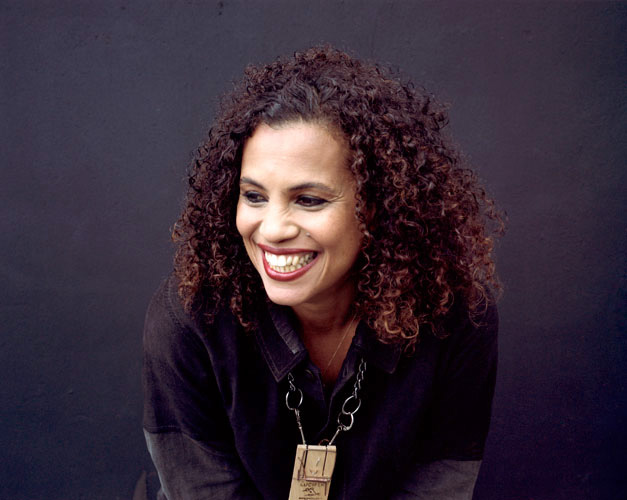
We’re speaking to you today about an album that you’ve done with The Thing. You like to work with other musicians despite have a lot of success as a solo artist. Do you think you work better in collaboration?
Neneh Cherry: It seems to me that it’s a very natural exchange which feeds my creativity. Obviously there’s a time and place where I need to sit down and to get into my own head, but the actual communication that happens in collaboration is everything for me and I’ll always go back to that. And even when I go back to my so-called solo stuff, it will feature collaborations. It’s always collaborations. It’s really about growth to me and being projected out of your own dimension into some new sharing experience.
Do you think doing a recorded collaboration and live shows with The Thing puts you outside of any notional comfort zone you might have?
NC: In a weird sort of way the project that ended up happening with The Thing ended up feeling like my ultimate comfort zone. But what’s amazing about this project is that it had to be a collaboration to work. They’re such power house musicians, we didn’t really know what was going to happen when we got together, so it basically just took off. We recorded three songs – one take of each song… right? And we didn’t really know what we were going to do, but we’d spoken via email and we’d said that we were going to use other people’s music as a starting point, so we were definitely going to do versions. So choosing the right songs that were going to be definitive and not difficult to get a handle on was important. But I felt a bit like I had grown wings instantly [laughs], you know? They have a very direct approach to the music they make.
Well I guess anyone who has more than a passing knowledge of Mats Gustafsson knows that he is a big fan of your dad, Don Cherry, and that The Thing are named after a Don Cherry piece, and they originally got together to play his music. But despite all this, everyone I mention this to has gone, ‘What? WHAT?’
NC: [laughs]
Maybe it’s the idea of your more honeyed vocal delivery in combination with his fairly abrasive, pummelling saxophone technique sounds a bit abrasive or weird, but it really works.
NC: Thank you.
Feature continues after photograph
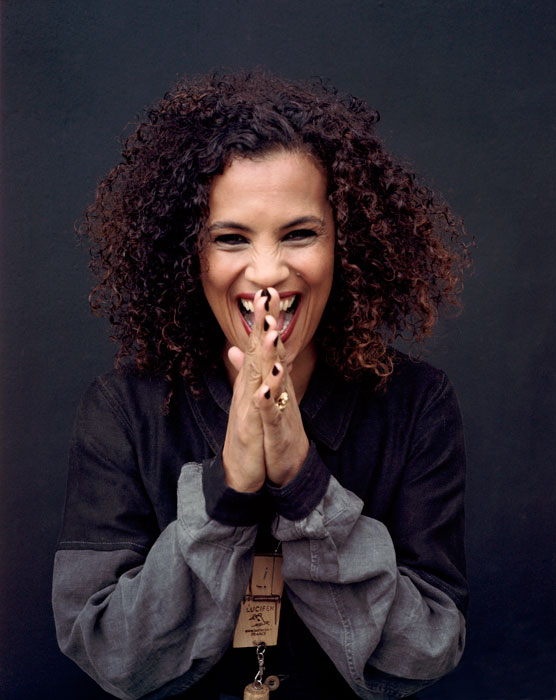
How did the idea first come about?
NC: We have a mutual friend in Sweden Conny C. Lindström who is an amazing person and he was the real force behind making this happen. I’d seen The Thing play in Stockholm where I’ve been living for the last six or seven years. Conny said that I should do something with these guys and my first reaction was to say: "No. I’m not good enough." Then eventually, "Ok" became the next stage, when I thought, "What have I actually got to lose?" It was interesting for me because it made me feel things that I hadn’t felt since I was in Rip, Rig and Panic. And there was an enormous relief at being away from a platform that made me quite self-conscious – where I might be reviewing myself. Sometimes you run the risk of doing that a bit too closely.
So anyway, Conny was the guy who planted the seed and the driving force behind it. He used to run a club called The Owl. The DJ would play a lot of free jazz. He would play a lot of music by Don, my dad, next to an old soul tune or a reggae tune. There were also a lot of younger Swedish free jazz musicians hanging out there, and it was interesting for me to go back into that environment where I hadn’t spent any time as an adult, seeing this whole network of young musicians who were fearlessly making noise. So that was the root of it but we met here in London in a studio in Acton run by a great musician engineer who actually co-produced the album Robert Harder. We set up and did the three songs.
What were the three initial tracks?
NC: We did the Martina Topley Bird track ‘Too Tough To Die’; we did a Nico song ‘Wrap Your Troubles In Dreams’ and we did the MF Doom track ‘Accordion’. And two of those made the album. And those literally just came about like this, “Right. How are we going to do this?” And then we just did it.
And obviously you’ve got strong ties to the whole Bristol scene. Did you meet Martina through Tricky or did you already know her?
NC: I met her through Tricky. I met her before the recording of Maxinquaye. The first time I met her was down in Spain. I was recording with Tricky and she was going out with/working with him. That must have been about 1993.
You did the three songs really quickly. Were you impressed with the results?
NC: [pause] Yeah… Yeah, I think we were all really happy. With The Thing, I don’t think they’d ever worked with a vocalist before. I mean, obviously they wanted to do this project but I don’t think any of us knew where it was going to land…
Totally. It’s amazing though! You can hear that they’re fighting this impulse to really start freaking out. I’m a big fan of Suicide and that cover of ‘Dream Baby Dream’ is probably the best song I’ve heard all year, it works so well…
NC: Oh, I’m so happy that you feel that way.
So who was it who broached the idea of doing one of Don’s songs then?
NC: That was Mats. The three of them together… When they said ‘Golden Heart’ I couldn’t [recall it]. There is so much of Don’s music that I know better than I know myself because it’s just in there, ingrained in my backbone, but I didn’t know ‘Golden Heart’ when they said "Let’s do this piece." I think it’s kind of a journey because it’s where I come from and because Don was a musician who meant a lot to them and has been a big inspiration for them, even though it felt like the right thing for us all to do. It was a similar reason why I wanted to do the Ornette track (‘What Reason’). It feels like a full journey. I don’t think I’ve ever been in the right place at the right time with the right musicians to do one of Don’s tracks in the right way before now.
With the MF Doom track, how did you go about converting a rap – and a weird, heavy, druggy rap at that – for yourself to sing?
NC: Well, I knew there wasn’t any way I was going to go in and rap it, and I think the whole reason to do a cover version is for you to find your own way through the song. I just went in and they started playing it and then I figured I would just say some of the words and then I just “heard” this melody. And it just kind of fell out. And it was done in one take… I think we were going to do another take but after that I got a massive headache… [roars laughing] I couldn’t actually go on!
For me there was something absolutely liberating about finding myself in a place with three musicians who knew what they were doing. With that you can’t [go wrong]. I mean, they have played together so many times that they are almost syncopated in a telepathic way. So in a way it’s just about listening, feeling and stepping out and showing how you feel without thinking about it too much. So it’s like, “Yeah, I might do a few weird things and I might fuck a few bits up but it’s just about the force of the expression.” So I sang a bit and then I started to rap a bit more and then went back to the melody and I was just riding it through with them. It made itself. That was the one that was like a stream of consciousness.
I guess it makes sense that some of the material should be improvised from your point as well.
NC: I think it has to be. We’ve only done two gigs together. We’re playing here in a few weeks and we’ve never done a rehearsal, we’ve only ever done sound checks. And I think it’s going to be really, really nice during the summer to go out and do a lot of gigs because it’s going to change a little bit each time, and we’re going to get to know each other a little more. The magic of it is when you’re feeding off each other you can hold back, push in the right place, listen… and not just feel like you’ve got to push on regardless.
The first gig we played in Stockholm was amazing because the electricity went for the whole south of Stockholm. We said, "What are we going to do? We’re just going to have to go on." And it was a little bit like the gods were in the house. So it was totally unamplified. It was at Connie’s place, this club called The Strand and he just lit lots of candles. And it was like a kind of magic. It was really silent in there, you could hear everything. None of the tills were working in the bar. Literally, right on the last song, the lights came on.
That sounds amazing.
NC: It was. And in the time we’re doing this thing together we belong together, and I think that was obvious from the first time we played together.
I’m going to ask you a question which might be too hard to answer, not because of its nature but just because of the width of it. But as regards this album, what lessons do you think you learned from your dad?
NC: I think that I carry a lot of things that I learned from my dad and my mother, but I think he really lived his music and he was a great philosopher of sound. But for all of his studying and knowledge of music he also had a naïve approach to it; a kind of freshness which meant that whatever he chose to do, it was always startling. I think that’s why he chose to play with a lot of younger musicians when he wasn’t playing with his crew. But he gave me the knowledge that there aren’t any rights and aren’t any wrongs. He taught me to keep growing and that I don’t own music. He taught me to keep it real and be who I am. There’s always been a part of me that hasn’t felt completely right in the pop dimension, in that clean scrubbed thing. So I’ve always felt a bit on the outskirts, a bit outside the norm so this for me feels like home, it feels really natural. Also the ghettos, the boundaries between all the different musical genres. I’ve never really understood that. There’s an element to Cherry Thing which is free jazz, but it’s also really punky.
Very much so. The Stooges! Suicide!
NC: I’ve always been at home with the idea of drawing from multiple sources. When I was growing up, we would hear all the music that Don was making with his people, but we also listened to everything else. Don drew from everything and I feel the same way.
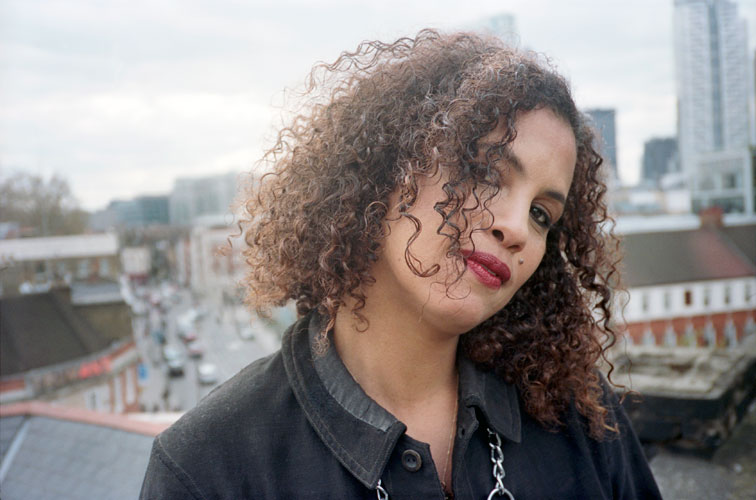
You’ve obviously got close ties to the post-punk scene in this country via Rip, Rig And Panic, The Pop Group and The Slits. So when you came to cover Suicide’s ‘Dream Baby Dream’, was this already a big song for you? And did the fact that Bruce Springsteen had covered it loom large in your mind at all?
NC: All I did was listen to the original. I can’t remember whether it was Connie or Mats who wanted to do it, we were swapping a lot tunes via email. I knew the song already and loved it and consider it to be part of my roots and my upbringing. But I focussed on the repetitive nature of it and when we were recording it, it was like I was saying a mantra. And I think there’s something about the sweetness of it, it’s very tender and beautiful. And I think that came up even more in our version through the horn part. Any tune you choose to cover, you have to love it, but you also have to feel like you can take it and make it your own. And then you’re not worried about the different versions of it or what the original sounds like it, you can just take the song and absorb it.
For sure. I’m a big fan of Suicide and I like Bruce Springsteen’s cover but I think your version knocks The Boss’s out of the stadium.
NC: [laughing] Hooray!
It must have been a very exciting time when you came over to Britain during the post-punk years. What was it like then?
NC: The feeling I got here when I started with Rip, Rig… First of all I had a very strong feeling of belonging, like I’d come home. I realised that these were my people. Especially with The Slits. Unfortunately Ari passed away recently but Tessa’s still a really great friend of mine. I bumped into Gareth [Sager, The Pop Group, Rip Rig + Panic] on the overground just now, who I haven’t seen for a while. I have a child together with Bruce Smith [The Pop Group/PiL] so we’re always in touch.
I felt really at home because it was connected to where I came from, and previous to that I’d always really felt a bit wrong and a bit awkward in many environments, especially growing up where I grew up in Sweden. Then New York had its ups and downs, and then when I came here I knew I was going to stay here for a long time. The openness – musically. The Pop Group guys, who became Rip Rig + Panic were listening to Sun Ra and Ornette Coleman and a lot of music I’d grown up listening to, but we made it our own thing. The creative anarchy of the times was amazing.
It doesn’t matter where I’m DJing – pub, club, concert venue, to whatever crowd. If things are going badly and I play ‘Buffalo Stance’ it will rescue the night and if things are going good, it will just take it up to the next level. What is it about that song? 25 years later, why has that song still got it?
NC: You tell me. It still surprises me! Maybe it’s just luck… Maybe it’s just… I don’t know… Hey DJ, why don’t you tell me? Ha ha ha! You’re the DJ! Ha ha ha!

